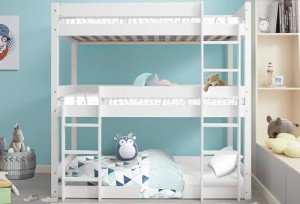Exploring Bunk Beds: A Comprehensive Guide
Bunk beds have actually long been a staple in kids's bedrooms, dorm rooms, and even homes with restricted space. Not only do they provide a practical sleeping solution, however they also develop a fun and creative environment for children and a great space-saver for adults and families. This short article will check out whatever you require to know about bunk beds, from types and materials to security tips and buying guidance.
Table of Contents
- Kinds Of Bunk Beds
- Standard Bunk Beds
- Loft Beds
- Triple Bunk Beds
- L-Shaped Bunk Beds
- Product Options
- Wood
- Metal
- Security Considerations
- Buying Guide
- FAQs
Kinds Of Bunk Beds
Bunk beds come in numerous designs to fit different requirements and preferences. Here's a breakdown of the most common types:
Conventional Bunk Beds
Conventional bunks typically include 2 beds stacked vertically on top of one another. These beds are perfect for siblings sharing a space or for maximizing sleeping space in visitor rooms.
Loft Beds
Loft beds stand similarly to standard bunk beds however do not have a lower sleeping area. Instead, they typically incorporate a desk or seating area underneath, making them a great choice for little rooms requiring multifunctionality.
Triple Bunk Beds
Triple bunk beds are designed for 3 occupants, with beds stacked in a three-tier setup. These are less typical however can be an enjoyable solution for big households or pajama parties.
L-Shaped Bunk Beds
With one bed placed horizontally and the other vertically, L-shaped bunk beds are typically equipped with extra functions such as desks or storage drawers and can match corner spaces in a room.
Contrast of Bunk Bed Types
| Bed Type | Ideal Use | Description |
|---|---|---|
| Conventional | Shared bed rooms or visitor spaces | 2 beds stacked vertically |
| Loft | Small rooms needing multi-purpose space | Upper bed with open space underneath |
| Triple | Large families or sleepovers | 3 beds stacked vertically |
| L-Shaped | Corner or flexible spaces | A combination of vertical and horizontal beds |
Product Options
Bunk beds are made from various products, with wood and metal being the most common. Adult Bunk Beds lonnycornella.top has its advantages and disadvantages.
Wood
- Resilience: Generally robust and can stand up to years of use.
- Aesthetic Appeal: Offers a timeless look that can blend with numerous decors.
- Weight Capacity: Typically stronger; can support heavier weights.
- Downsides: May be more expensive than metal options and can be susceptible to scratches.
Metal
- Sturdiness: Generally light-weight and easy to move but still sturdy.
- Modern Design: Often is available in streamlined styles, making it appealing for modern spaces.
- Economical: Usually cheaper than wood options.
- Drawbacks: Can be cold to the touch in winter seasons and may not have the exact same visual appeal for some buyers.
Safety Considerations
When it comes to bunk beds, security can not be overlooked. Here are key safety tips to bear in mind:
- Guardrails: Ensure that the leading bunk has guardrails on both sides to avoid falls.
- Sturdy Construction: Check for a solid build and tough materials to hold up against weight and motion.
- Weight Limit: Adhere to the manufacturer's weight limit for both the upper and lower bunks.
- Ladder Design: Choose bunks with a safe, easy-to-climb ladder and prevent any sharp edges or rungs.
- Age Restrictions: Most makers suggest that children under the age of 6 should not sleep in the upper bunk.
Purchasing Guide
When looking for bunk beds, consider the list below aspects to discover the very best fit for your needs:
- Space Availability: Measure the space size and ceiling height, ensuring there is appropriate space for the leading bunk.
- Bed Size: Decide in between twin, full, or bigger sizes based on your requirements and the size of the room.
- Design Preference: Consider the overall decoration of the bedroom to discover an appropriate style.
- Reduce of Setup: Look for a bunk bed that is straightforward to put together.
- Budget plan: Bunk beds are available in various rate varieties, so figure out a budget plan before starting your search.
Frequently asked questions
1. What is the advised age for kids to sleep on the leading bunk?
Children aged 6 and older are normally suggested to sleep on the leading bunk to minimize the risk of falls.
2. How can I make my bunk bed safer?
To improve safety, ensure guardrails are effectively set up and inspect that the bed is put on a flat surface area. In addition, encourage children to utilize the ladder thoroughly.
3. Can I convert a bunk bed into 2 different beds?
Lots of bunk beds are designed to be convertible. Check the maker's specifications for convertibility functions.
4. What accessories are available for bunk beds?
Typical devices include bed linens, storage drawers, staircases instead of ladders, and tented canopies for a fun visual appeal.
5. How do I keep my bunk bed?
Regular checks for loose screws or structural stability can help ensure security. Dust the bed frequently and clean spills promptly to keep the products in good condition.
Bunk beds are flexible and a space-efficient option for numerous living situations, from kids's rooms to guest lodgings. With numerous styles and materials offered, potential purchasers have a wealth of alternatives to think about, ensuring a mix of usefulness and aesthetics. By focusing on security and following the tips outlined in this guide, people can discover the right bunk bed that matches their space and lifestyle, all while creating an enjoyable sleeping environment.

